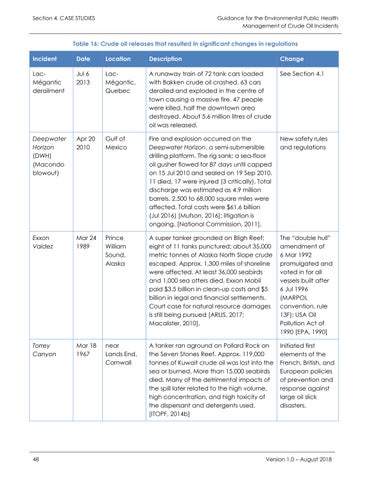Section 4. CASE STUDIES
Guidance for the Environmental Public Health Management of Crude Oil Incidents
Table 16: Crude oil releases that resulted in significant changes in regulations Incident
Date
Location
Description
Change
LacMégantic derailment
Jul 6 2013
LacMégantic, Quebec
A runaway train of 72 tank cars loaded with Bakken crude oil crashed. 63 cars derailed and exploded in the centre of town causing a massive fire. 47 people were killed, half the downtown area destroyed. About 5.6 million litres of crude oil was released.
See Section 4.1
Deepwater Horizon (DWH) (Macondo blowout)
Apr 20 2010
Gulf of Mexico
Fire and explosion occurred on the Deepwater Horizon, a semi-submersible drilling platform. The rig sank; a sea-floor oil gusher flowed for 87 days until capped on 15 Jul 2010 and sealed on 19 Sep 2010. 11 died, 17 were injured (3 critically). Total discharge was estimated as 4.9 million barrels. 2,500 to 68,000 square miles were affected. Total costs were $61.6 billion (Jul 2016) [Mufson, 2016]; litigation is ongoing. [National Commission, 2011].
New safety rules and regulations
Exxon Valdez
Mar 24 1989
Prince William Sound, Alaska
A super tanker grounded on Bligh Reef; eight of 11 tanks punctured; about 35,000 metric tonnes of Alaska North Slope crude escaped. Approx. 1,300 miles of shoreline were affected. At least 36,000 seabirds and 1,000 sea otters died. Exxon Mobil paid $3.5 billion in clean-up costs and $5 billion in legal and financial settlements. Court case for natural resource damages is still being pursued [ARLIS, 2017; Macalister, 2010].
The “double hull” amendment of 6 Mar 1992 promulgated and voted in for all vessels built after 6 Jul 1996 (MARPOL convention, rule 13F); USA Oil Pollution Act of 1990 [EPA, 1990]
Torrey Canyon
Mar 18 1967
near Lands End, Cornwall
A tanker ran aground on Pollard Rock on the Seven Stones Reef. Approx. 119,000 tonnes of Kuwait crude oil was lost into the sea or burned. More than 15,000 seabirds died. Many of the detrimental impacts of the spill later related to the high volume, high concentration, and high toxicity of the dispersant and detergents used. [ITOPF, 2014b]
Initiated first elements of the French, British, and European policies of prevention and response against large oil slick disasters.
48
Version 1.0 – August 2018







